 A couple years ago, some of us at Benchmark noticed a weird discrepancy between our HPA2™ headphone amp (built into our DAC1 and DAC2) and some comparably-priced headphone amps. The advertised specifications of all the amps were basically the same, but they sounded noticeably different. Benchmark launched a detailed investigation to identify the differences. The results were surprising and are detailed in a white paper...
A couple years ago, some of us at Benchmark noticed a weird discrepancy between our HPA2™ headphone amp (built into our DAC1 and DAC2) and some comparably-priced headphone amps. The advertised specifications of all the amps were basically the same, but they sounded noticeably different. Benchmark launched a detailed investigation to identify the differences. The results were surprising and are detailed in a white paper...Buy one component and save 10% on up to 2 cables. Buy 2 components and get 4 free cables. Free shipping on USA orders over $700.
Buy one component and save 10% on up to 2 cables. Buy 2 components and get 4 free cables. Free shipping on USA orders over $700.
Audio Application Notes
Crossover Distortion - Video Clip
by John Siau March 14, 2016
The AHB2 - A new and radically different audio power amplifier! Dick Olsher once said that "the first Watt is the most important Watt".
This short 8-second video clip demonstrates some of the differences.
- John Siau
AHB2 Crossover Distortion Measurements
by John Siau March 10, 2016
Crossover Distortion - Measurements
The following measurements and scope photos demonstrate the effectiveness of the feedforward system in the AHB2.
From the first Watt to the last Watt, the AHB2 shows no evidence of crossover distortion. In contrast, all conventional class-AB amplifiers have crossover-distortion artifacts.
Dick Olsher once said that "the first Watt is the most important Watt". I agree!
- John Siau
Amplifier Crossover Distortion
by John Siau March 10, 2016
Crossover Distortion - Introduction
Most audio power amplifiers suffer from a defect known as "crossover distortion". This distortion is particularly troublesome at low output levels. At low power levels, the crossover distortion can rise to a high percentage of the output level and become the dominant source of distortion.
- John Siau
How Should I Buy an Audio System?
by John Siau February 26, 2016
Two Distinct Types of Audio Products - Understand the Difference Before You Buy!

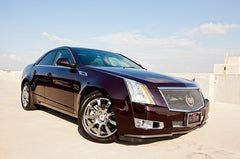
Make your own choice!
"Buying an audio product is much like buying a car"
There are two distinct types of audio products. Some audio products are designed to be transparent while others are designed to provide a euphonic experience. These types are as different as a Porsche and a Cadillac.
There is not a right and wrong type of car. Likewise there is not a right and wrong type of audio product. The choice belongs to the user, but the user must be fully aware of the differences before they buy.
- John Siau
Star Quad Cable Demonstration - Video
by John Siau February 12, 2016
Benchmark has recorded a lab demonstration that shows what happens when a standard two-wire cable is exposed to common sources of magnetic interference.
You will be able to hear the interference, see it on an oscilloscope, and view its spectrum on an FFT. A star-quad cable is exposed to the same sources of magnetic interference and the results are compared. This demonstration shows the dramatic difference between the two cables. The star-quad cable provided a 20 to 50 dB reduction in magnetic interference, keeping the interference below audible levels.
- John Siau
The Importance of Star-Quad Microphone Cable
by John Siau February 12, 2016
Eliminate Magnetic Interference with Star-Quad Cable

Studios, live sound venues and homes all have magnetic fields that can cause interference. Magnetic fields are produced whenever current flows through a wire. AC power cables, transformers, power supplies, computers, portable chargers, motors and light dimmers are among the devices that can emit strong magnetic fields. A microphone cable can pick up magnetic interference if it happens to pass near one of these devices. Cables can also pick up magnetic fields when they run adjacent to AC power. Star-quad cables typically reduce this magnetic interference by at least 20 to 30 dB. This is almost always enough to reduce the interference to inaudible levels.
- John Siau
Benchmark DAC2 vs. DAC1 - Side-by-Side Measurements
by John Siau August 13, 2015


There was a 10-year time span between the introduction of the Benchmark DAC1 and DAC2 audio D/A converters. The DAC1 defined the state of the art when it was introduced in 2002. Thirteen years later, Enjoy the Music.com selected the DAC1 as one of the 20 most significant digital audio products from the past 20 years. Today the DAC2 defines the state of the art in audio D/A conversion. John Atkinson said that the "DAC2 offered one of the highest resolutions I have measured." Both products set performance benchmarks when they were introduced. In a sense, they provide snapshots of technological progress.
This paper shows high-precision side-by-side measurements of the DAC1 and DAC2 converters. These measurements show how technology has improved, and they show that there may be two or three audible differences between these two products.
Travel through 10 years of audio technology, learn the significance of audio measurements, and see what has improved in our quest for transparent audio reproduction.
- John Siau
Benchmark DAC2 vs. DAC1 - Is There an Audible Difference?
by John Siau August 06, 2015
Benchmark introduced the DAC1 in 2002 and it quickly became the best-selling 2-channel professional D/A converter. To this day, the DAC1 is a standard fixture in many recording studios, and it is also a central component in many high-end hi-fi systems. In August of 2015, Enjoy the Music.com selected the DAC1 as one of the 20 most significant digital audio products from the past 20 years.
It is easy to show that the DAC2 measures better than the DAC1 in almost every way. From a marketing perspective it would be tempting to claim that all of these measured differences make audible improvements, but this just isn't the case.
One reviewer, Gary Galo, recently had the opportunity to hear a DAC1 and DAC2 side-by-side. He noted some audible differences and we agree with his conclusions. We have had a great deal of experience listening to these converters side-by-side in our own listening room and we are familiar with some subtle differences.
This paper examines the subtle audible differences between the DAC1 and the DAC2. It also includes measurements that may help to explain these differences.
- John Siau
The HPA2™ Headphone Power Amplifier
by John Siau July 22, 2015
Why do I need a Power Amplifier to Drive My Headphones?
Many Benchmark products include our HPA2™ headphone power amplifier. Unlike most headphone amplifiers, the HPA2™ is designed to behave like a small but very clean power amplifier. What makes the HPA2™ different, and what do we mean when we say that the HPA2™ is a "power amplifier"?
- John Siau
Box-to-Box Phase Accuracy of Benchmark DAC1 and DAC2 Converters
by John Siau October 03, 2014
Phase Accurate Multi-Channel D/A Conversion
- Using Multiple DAC1 or DAC2 Converters
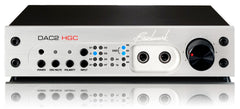

Two or more Benchmark DAC1 or DAC2 converters can be used together in phase-coherent multichannel audio systems even though their internal clocks are not synchronized. This seems to defy logic, but an examination of the system details reveals why this is possible.
- John Siau
The AHB2 - A Radical Approach to Audio Power Amplification
by John Siau July 30, 2014
 Radical!
Radical!

The performance of the AHB2 would not have been achievable without taking a radical approach to power amplification. In many ways, the AHB2 is a complete 180 degree departure from traditional high-end amplifier designs. There is nothing ordinary about the Benchmark AHB2! It is also not a class-D amplifier!
Take a look inside this unique linear audio power amplifier!

The CE Mark - A Photo-Tour of Immunity Testing
by John Siau June 25, 2014
Testing for Immunity to Interference
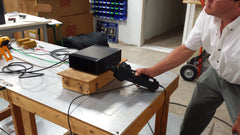
- John Siau
The CE Mark - What Does it Mean, and Why Should I Care?
by John Siau June 17, 2014
Why is the CE Mark Important?
Many electronic products have a "CE" mark affixed to the product. This mark is mandatory in European markets, but is not required on products sold elsewhere. Few people understand what this mark means and why it is important. It is often a good idea to look for this mark when purchasing a product. It is also important to understand the differences between professional and consumer audio products (as defined in the CE standards).
- John Siau
Headphone Amplifiers - Part 2
by John Siau March 20, 2014
It's all about control! - Headphone Output Impedance
The movement of headphone transducers must be well controlled in order to produce high-quality audio. It is easy to build a headphone amplifier that produces sound. It is an entirely different matter to produce an amplifier that is clear, clean, and enjoyable.

Headphone amplifiers need power and accuracy to achieve control. They also need to be protected from short circuits and overload conditions. The cheap, dirty, and common way to protect the amplifier is to add a series resistor between the amplifier and the headphone jack. This simple solution protects the amplifier from short circuits and overloads. Unfortunately, the resistor isolates the headphones from the amplifier, causing a loss of control. This ...
Headphone Amplifiers - Part 1
by John Siau March 14, 2014
Headphones do not Behave Like a Resistor - Beware of Misleading Specifications!
 A couple years ago, some of us at Benchmark noticed a weird discrepancy between our HPA2™ headphone amp (built into our DAC1 and DAC2) and some comparably-priced headphone amps. The advertised specifications of all the amps were basically the same, but they sounded noticeably different. Benchmark launched a detailed investigation to identify the differences. The results were surprising and are detailed in a white paper...
A couple years ago, some of us at Benchmark noticed a weird discrepancy between our HPA2™ headphone amp (built into our DAC1 and DAC2) and some comparably-priced headphone amps. The advertised specifications of all the amps were basically the same, but they sounded noticeably different. Benchmark launched a detailed investigation to identify the differences. The results were surprising and are detailed in a white paper...An Examination of Headphone Amplifier Performance Specifications
by John Siau November 11, 2011
Headphone Amplifier Whitepaper
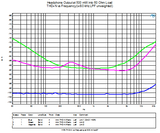 Recording Engineers and Audiophiles often distrust audio measurements and specifications. It is not uncommon to hear claims that a product measures poorly but sounds good. Occasionally we also hear claims that a product measures well but sounds bad.
Recording Engineers and Audiophiles often distrust audio measurements and specifications. It is not uncommon to hear claims that a product measures poorly but sounds good. Occasionally we also hear claims that a product measures well but sounds bad.
This whitepaper documents significant differences between three headphone amplifiers that have nearly identical published specifications.
Asynchronous Upsampling to 110 kHz
by John Siau July 01, 2010
The Advantages of Asynchronous Upsampling D/A Converters
Benchmark DAC1 converters use upsampling techniques to improve the quality of the digital to analog conversion. Benchmark’s choice of 110 kHz is slightly unorthodox. It may seem more logical to upsample by 2X or 4X and convert at standard sample rates such as 88.2 kHz, 96 kHz, 176.4 kHz or even 192 kHz. Intuition may suggest that integer ratios would produce the best results. Intuition may also suggest that higher is better, and therefore 192 kHz would be the “best” choice for an output sample rate. Unfortunately, intuition often leads us down the wrong path if it is not balanced with reason and scientific analysis. Benchmark’s analysis and testing has shown that 110 kHz offers advantages over the choices that seem more reasonable.
This paper is a short summary of the decisions that led to our choice of the 110 kHz sampling rate.
Volume Control Technologies
by John Siau April 24, 2010
Fix the Weakest Link in the Audio Chain!
A playback system's volume control is often one of the weakest links in the audio chain. This is especially true when remote control is required.
Benchmark’s HDR-VC™ (High Dynamic Range Volume Control), combines the best features of two distinct volume control methods while adding remote volume control.
- How does a volume control degrade the sound?
- What are the different volume control methods?
- Are some sonically superior, and why?
Jitter and its Effects
by John Siau February 07, 2002
By John Siau and Allen H. Burdick
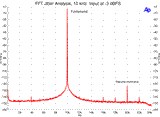
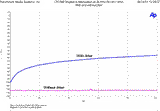
This paper addresses these questions:
- How and where do I measure jitter, and how do I eliminate it?
- How does sample clock jitter relate to interface jitter measured at digital output connectors?
- How can we accurately measure jitter?
- Why does sample clock jitter have to be so low?
The "0-Ohm" Headphone Amplifier
by John Siau December 01, 2001
An Introduction to "The 0-Ohm Headphone Amplifier" White Paper
 The circuits used to drive headphones are often added to a product without careful consideration of the difficult loads presented by high-quality headphones. The most common circuit is an opamp driver followed by a 30-Ohm series resistor. The series resistor provides short-circuit and overload protection while isolating the opamp from the inductance and capacitance of the headphones. The series resistor protects the opamp while keeping it stable. In contrast, today's state-of-the-art headphone amplifiers eliminate the series resistor, and use a high current driver. This change reduces distortion and flattens the frequency response when a headphone is driven. These new high-end designs are often called "0-Ohm" headphone amplifiers, and are ...
The circuits used to drive headphones are often added to a product without careful consideration of the difficult loads presented by high-quality headphones. The most common circuit is an opamp driver followed by a 30-Ohm series resistor. The series resistor provides short-circuit and overload protection while isolating the opamp from the inductance and capacitance of the headphones. The series resistor protects the opamp while keeping it stable. In contrast, today's state-of-the-art headphone amplifiers eliminate the series resistor, and use a high current driver. This change reduces distortion and flattens the frequency response when a headphone is driven. These new high-end designs are often called "0-Ohm" headphone amplifiers, and are ...




















